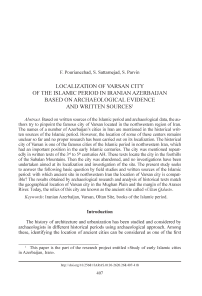Localization of Varsan city of the Islamic period in Iranian Azerbaijan based on archaeological evidence and written sources
Автор: Pourianezhad F., Sattarnejad S., Parvin S.
Журнал: Краткие сообщения Института археологии @ksia-iaran
Рубрика: Археология старого и нового света
Статья в выпуске: 268, 2022 года.
Бесплатный доступ
Based on written sources of the Islamic period and archaeological data, the authors try to pinpoint the famous city of Varsan located in the northwestern region of Iran. The names of a number of Azerbaijan's cities in Iran are mentioned in the historical written sources of the Islamic period. However, the location of some of these centers remains unclear so far and no proper research has been carried out on its localization. The historical city of Varsan is one of the famous cities of the Islamic period in northwestern Iran, which had an important position in the early Islamic centuries. The city was mentioned repeatedly in written texts of the 3rd to 5th centuries AH. These texts locate the city in the foothills of the Sabalan Mountains. Then the city was abandoned, and no investigations have been undertaken aimed at its localization and investigation of the site. The present study seeks to answer the following basic question by field studies and written sources of the Islamic period: with which ancient site in northwestern Iran the location of Varsan city is compatible? The results obtained by archaeological research and analysis of historical texts match the geographical location of Varsan city in the Mughan Plain and the margin of the Araxes River. Today, the relics of this city are known as the ancient site called «Ultan Qalasi».
Iranian azerbaijan, varsan, oltan site, books of the islamic period
Короткий адрес: https://sciup.org/143180137
IDR: 143180137 | DOI: 10.25681/IARAS.0130-2620.268.407-418
Список литературы Localization of Varsan city of the Islamic period in Iranian Azerbaijan based on archaeological evidence and written sources
- Abu Dulaf, 1975. Abu Dulaf travel book in Iran. Tehran: Zav’ar Publications.
- Abulfeda I., 2006. Taqwim al-Buldan. Cairo: Al-Thaqafa Al-Diniya Publications.
- Al-Baladhuri A., 1958. Futuh al-Buldan / Transl. by M. Tavakol. Tehran: Noqreh.
- Alizadeh K., 2011. Ultan Qalasi: A Fortified Site in the Sasanian Borderlands (Mughan Steppe, Iranian Azerbaijan) // Iran. Vol. 49. No. 1. P. 55–77.
- Al-Yaqoubi A., 2001. Al-Buldan. Beirut: Dar Al-Kitab Al-Almiyeh Publications.
- Amirhajlou S., Saqaei S., 2018. Distribution, Continuity and Diversity of Islamic Ceramics in the Settlements of Narmashir Plain, Kerman // Pazhoheshha-ye Bastan shenasi Iran. No. 8 (19). P. 207–226.
- Amirhajlou S., Sediqian H., 2019. Archaeological Research on Islamic Pottery from Qal´eh Sang, Old Sirjan (Kerman Province, Iran) // Pazhoheshha-ye Bastan shenasi Iran. No. 10 (25). P. 155–180.
- Baghdadi Q., 1981. Masalak and Malikas. Beirut: Dar al-sader.
- Chubak H., 2012. Report of Islamic Pottery, Povinik Castle. Tehran: Cultural Heritage Organization. Hemmati Azandariani E., Khaksar A., Shabani A., 2015. Studying and Analyzing the Islamic Potteries from Underground Troglodytic Architecture Complex at Samen, Malayer // Archaeological Research. No. 13. P. 189–206.
- Ibn al-Faqih A., 1995. Short translation of Al-Buldan. Tehran: Cultural Foundation.
- Ibn Khaldun A., 1987. Ibn Khaldun’s history. Vol. 3. Lebanon. Beirut: Dar al-Fikr Publications.
- Ibn Rustah A., 2020. Al-A‘laq al-Nafisa. Beirut: Dar Sader.
- Istakhri I., 1961. Al-Masalik wa-l-Mamalik, by Iraj Afshar. Tehran: Book Translation Publishing House.
- Khancherli M., 2015. Study of pottery of the first centuries of Islam in Ardabil province: M. A. Thesis in Archeology, Mohaghegh Ardabili University.
- Khodadoost J., Mousavi Haji S., Taghavi A., Pooraliyari S., 2015. An Analytical Study of the Pottery at the Malin Site (Bakharz) // Pazhoheshha-ye Bastan shenasi Iran. No. 7 (13). P. 157–172.
- Maqdisi A., 2010. Ahsan al-Taqasim fi al-Marafa al-Aqalim. Beirut: Dar al-Asaq.
- Mostofi H., 2002. Nuzhat al-Qulob, edited by Muhammad Dabir Siagi. Qazvin: Hadith Imroz Publications. Pakbaz D., Neyestani J., Karimian H., 2019. Localization of Ziz city based on historical sources and archaeological surveys // Journal of Archaeological Studies. Vol. 11. No. 2. P. 7–56.
- Qazvini Z., 1995. Asar al-Bilad Akhbar al-Ibad. Tehran: Amirkabir Publications.
- Ranjbaran M.R., 2012. Final report of the first and second chapters of the archaeological exploration of Hagmatana hill, Hamadan province // Cultural heritage.
- Sattarnejad S., Parvin S., 2019. Manifestation of Islamic Decorative Arts in the Architecture of Gonbad- e-Kabood and Gonbad-e-Ghaffariyeh // ANASTASIS. Research in Medieval Culture and Art. Vol. VI. No. 2. P. 1–18.
- Sattarnejad S., Parvin S., Hendiani E., 2020a. Chronology of the historical context of Maragheh City based on archaeological exploration and historical written sources // КСИА. Вып. 260. P. 397–406.
- Sattarnejad S., Parvin S., Hendiani E., 2020b. The symbology of swastika in the Gonbad-e-Sorkh Tomb // Codrul Cosminului. Vol. 26 (1). P. 7–18.
- Sharahi E., Sediqian H., 2019. Archaeological study of medieval Islamic pottery in the underground part of Tahiq Khomeini // Archaeological Studies of Parseh No. 8. P. 151–148.
- Tahmasebi F., 2019. Report of the first season of archaeological excavations of Yale Sui site // Cultural Heritage Research Institute.
- Velayati R., Mehdizadeh B., Khanali H., 2015. Location of Ojan Ilkhanid City Based on Historical Resources and Archaeological Investigations (Research on Sites of Koller and Dali Darasi in Bostan Abad City) // Bagh-e Nazar. No. 12 (34). P. 83–92.
- Wordsworth P., 2018. Problematising the shifting capitals of Medieval Arran: From Bardhaʿa to Janza in the 10th–12th centuries // Iran. Vol. 56. No. 1. P. 64–76.


